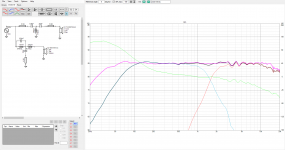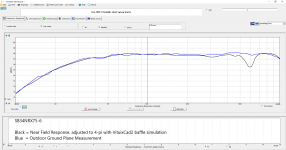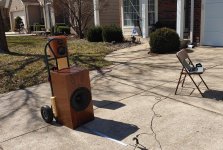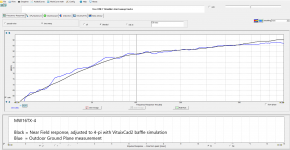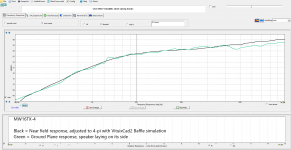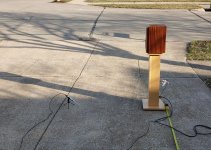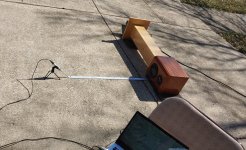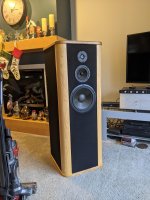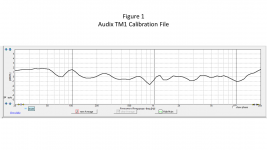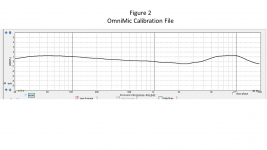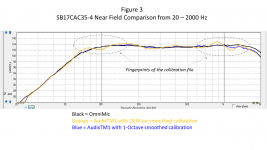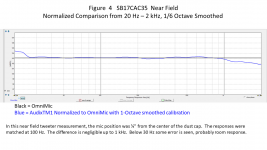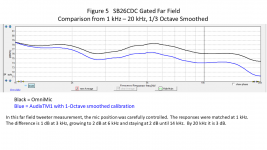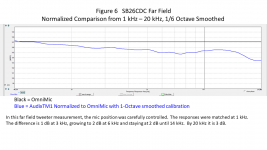I was reading through the Hypex fusion amp mega thread
The New Hypex Fusion Plate amps
I think I now know why I had to adjust my driver levels based on direct measurement (i.e. why my simulation driver levels did not match reality)... In the Hypex software, levels are set in dB referenced to the maximum output of the amp. The woofer and the mid amps are both 250 W, but the tweeter amp is 100 W.
This means that "0" dB on the woofer and mid will be 4 dB higher drive voltage than "0" dB on the tweeter.
I now remember fussing over this fact last year, but it must have gotten flushed down the brain drain at some point...
The New Hypex Fusion Plate amps
I think I now know why I had to adjust my driver levels based on direct measurement (i.e. why my simulation driver levels did not match reality)... In the Hypex software, levels are set in dB referenced to the maximum output of the amp. The woofer and the mid amps are both 250 W, but the tweeter amp is 100 W.
This means that "0" dB on the woofer and mid will be 4 dB higher drive voltage than "0" dB on the tweeter.
I now remember fussing over this fact last year, but it must have gotten flushed down the brain drain at some point...
When it comes to passive crossovers, I am not an expert. Far from it.
But I find the process interesting, and now that I have a good working simulation of my system, I gave it a shot.
Attached is a passive crossover for the MW16TX-4 and the TW29TXN-B. Using passive components, I matched the target responses of the two drivers. The result is a 1.6 kHz crossover with 4th order acoustic slopes. I was surprised that 3rd order electrical topology would generate 4th order slopes on both the woofer and tweeter, but it did.
The purple "magenta" line is the simulation from my active system. The only real differences are at the extremes. The bass response of the 2 way is obviously limited in comparison to the active system's 12 inch woofer. At high end, you can see that on the active system I used some EQ above 12 kHz to flatten out the response a bit.
The passive system as it stands would need a subwoofer, but it would be ideal for that application. The MW16TX-4 in a 12 liter sealed box has an Fc of about 75 Hz, so subwoofer integration should be easy.
Alternatively, the box could be increased to about 20 liters, and then vented to an Fb tuning frequency of 36 Hz. This would give an F3 of about 40 Hz and an F9 of about 30 Hz.
I have no intention of building this, but it is an interesting exercise.
But I find the process interesting, and now that I have a good working simulation of my system, I gave it a shot.
Attached is a passive crossover for the MW16TX-4 and the TW29TXN-B. Using passive components, I matched the target responses of the two drivers. The result is a 1.6 kHz crossover with 4th order acoustic slopes. I was surprised that 3rd order electrical topology would generate 4th order slopes on both the woofer and tweeter, but it did.
The purple "magenta" line is the simulation from my active system. The only real differences are at the extremes. The bass response of the 2 way is obviously limited in comparison to the active system's 12 inch woofer. At high end, you can see that on the active system I used some EQ above 12 kHz to flatten out the response a bit.
The passive system as it stands would need a subwoofer, but it would be ideal for that application. The MW16TX-4 in a 12 liter sealed box has an Fc of about 75 Hz, so subwoofer integration should be easy.
Alternatively, the box could be increased to about 20 liters, and then vented to an Fb tuning frequency of 36 Hz. This would give an F3 of about 40 Hz and an F9 of about 30 Hz.
I have no intention of building this, but it is an interesting exercise.
Attachments
As I mentioned in an earlier post, I have been waiting to go outdoors for a ground plane measurement. The weather has been quite nice this past week, so I got this part done.
According to theory, a ground plane measurement is equivalent to a 4-pi anechoic measurement, except that the SPL will be 6 dB higher than anechoic. With the mic very close to the ground, it is in a reflection free zone. Erin showed us that ground plane measurements can be very accurately made all the way up to 20 kHz. Measuring Response: How close is "close enough" to anechoic? . However, my goals were simply to capture the low frequency behavior of my drivers.
The most widely used method of capturing the low frequency response of drivers is to measure the near field response. NF measurements are very accurate, but they represent a 2-pi (infinite baffle) response. To be useful, NF measurements must be adjusted to be “4-pi equivalent”. This is what I did in my project. I used the baffle step simulation in VituixCad2 to adjust the NF measurement into the equivalent of a 4-pi free space measurement.
I have been curious about the accuracy of this method. How accurate was my baffle simulation? How close does theory match reality? This is why I wanted to make a ground plane measurement. If all the measurements and simulations are done properly, the ground-plane (GP) response should be the same as the near-field-with-baffle-adjustment (NF4pi for short).
My ground plane measurements took place on my driveway, with the microphone at a distance of 36 inches, and the mic ¼ inch from the ground. The nearest wall was 20 ft away.
The first driver tested was the woofer. In this case, the GP response is very close to the NF4pi response. It looks like I was able to get resolution all the way down to 10 Hz (!). On the upper end, the near field measurement shows a cancellation null at 600 Hz. The cone is about ½ wavelength in diameter at 600 Hz.
The mid driver in the satellite was tested two ways, standing up and laying on the side (my satellite is firmly bolted to the stand). First shown is the upright measurement. I get a very good match from 100 up to 500 Hz, and then a slightly reduced GP response above that. I suspect this is due to the off-axis response of the mid driver. Below 100 Hz the GP response is a bit lumpy.
Laying the satellite on its side puts the driver very close to the ground. Now the match between GP and NF4pi is very good from 25 Hz through 400 Hz, but the GP response is somewhat depressed above that. Since the mic is on-axis with the driver, this response anomaly must be diffraction or reflection related. My guess is the stand, particularly the base.
My conclusion is that the NF4pi response matches the GP response close enough to give me confidence that I did the near-field-with-baffle-adjustment process correctly.
j.
According to theory, a ground plane measurement is equivalent to a 4-pi anechoic measurement, except that the SPL will be 6 dB higher than anechoic. With the mic very close to the ground, it is in a reflection free zone. Erin showed us that ground plane measurements can be very accurately made all the way up to 20 kHz. Measuring Response: How close is "close enough" to anechoic? . However, my goals were simply to capture the low frequency behavior of my drivers.
The most widely used method of capturing the low frequency response of drivers is to measure the near field response. NF measurements are very accurate, but they represent a 2-pi (infinite baffle) response. To be useful, NF measurements must be adjusted to be “4-pi equivalent”. This is what I did in my project. I used the baffle step simulation in VituixCad2 to adjust the NF measurement into the equivalent of a 4-pi free space measurement.
I have been curious about the accuracy of this method. How accurate was my baffle simulation? How close does theory match reality? This is why I wanted to make a ground plane measurement. If all the measurements and simulations are done properly, the ground-plane (GP) response should be the same as the near-field-with-baffle-adjustment (NF4pi for short).
My ground plane measurements took place on my driveway, with the microphone at a distance of 36 inches, and the mic ¼ inch from the ground. The nearest wall was 20 ft away.
The first driver tested was the woofer. In this case, the GP response is very close to the NF4pi response. It looks like I was able to get resolution all the way down to 10 Hz (!). On the upper end, the near field measurement shows a cancellation null at 600 Hz. The cone is about ½ wavelength in diameter at 600 Hz.
The mid driver in the satellite was tested two ways, standing up and laying on the side (my satellite is firmly bolted to the stand). First shown is the upright measurement. I get a very good match from 100 up to 500 Hz, and then a slightly reduced GP response above that. I suspect this is due to the off-axis response of the mid driver. Below 100 Hz the GP response is a bit lumpy.
Laying the satellite on its side puts the driver very close to the ground. Now the match between GP and NF4pi is very good from 25 Hz through 400 Hz, but the GP response is somewhat depressed above that. Since the mic is on-axis with the driver, this response anomaly must be diffraction or reflection related. My guess is the stand, particularly the base.
My conclusion is that the NF4pi response matches the GP response close enough to give me confidence that I did the near-field-with-baffle-adjustment process correctly.
j.
Attachments
I am doubly lucky that hifijim is just down the road from me and that he invited me over for a listen to his new textreme speakers.
His system is stellar. No matter what we listened to, with my eyes closed, my ears could not find where the speakers were located. When a cymbal crashed it was huge and seemed to be bigger than the room. It was a really odd feeling hearing something that my ears said was taller than the room. If the music was recorded in a stadium, I felt like I was in a big stadium. I use JBL 580's for my home theater and they have never given me the same sense of space.
The bass made me laugh out loud when he played a track from a movie soundtrack because of how clean and powerful it was. Nothing boomy or flabby about the bass either. We jammed out to a "Rodrigo y Gabriela" song and the hits to the guitar have never sounded so good to me. It was always just the right amount and did not overpower things. Really his whole system just sounded so nicely integrated.
At the end of the session, I told hifijim that he actually made a star trek transporter (holodeck if you are a TNG fan) since it took me to different places. I felt like I jumped around from different stadiums and nightclubs the whole session.
I don't know if it is odd having a single random outside review for a DIY speaker but I thought I should write up the experience.
Thanks again for having me over. I had a ton of fun and you set the bar for my ears.
His system is stellar. No matter what we listened to, with my eyes closed, my ears could not find where the speakers were located. When a cymbal crashed it was huge and seemed to be bigger than the room. It was a really odd feeling hearing something that my ears said was taller than the room. If the music was recorded in a stadium, I felt like I was in a big stadium. I use JBL 580's for my home theater and they have never given me the same sense of space.
The bass made me laugh out loud when he played a track from a movie soundtrack because of how clean and powerful it was. Nothing boomy or flabby about the bass either. We jammed out to a "Rodrigo y Gabriela" song and the hits to the guitar have never sounded so good to me. It was always just the right amount and did not overpower things. Really his whole system just sounded so nicely integrated.
At the end of the session, I told hifijim that he actually made a star trek transporter (holodeck if you are a TNG fan) since it took me to different places. I felt like I jumped around from different stadiums and nightclubs the whole session.
I don't know if it is odd having a single random outside review for a DIY speaker but I thought I should write up the experience.
Thanks again for having me over. I had a ton of fun and you set the bar for my ears.
Headshake - thanks for sharing your thoughts. It is really nice to have a second opinion about my system. I am looking forward to hearing your system when it is complete.
Headshake is building an active system using Hypex FA123 amps. The mid is a very interesting driver, an Eton 3" hex cone driver, mated to a BlieSMA T25B. Bass is a SEAS L26ROY.
Jim
Headshake is building an active system using Hypex FA123 amps. The mid is a very interesting driver, an Eton 3" hex cone driver, mated to a BlieSMA T25B. Bass is a SEAS L26ROY.
Jim
I'm watching this closely.
I'm using the 1 inch ceramic SB tweeter
5" hex cone mid from Eton.
11" hex cone from Eton.
I need to build different cabinets and I'm wondering; do I stay with my drivers which I still love or do I use the 5" ceramic or the 5" textreme?
decisions.....
I'm using the 1 inch ceramic SB tweeter
5" hex cone mid from Eton.
11" hex cone from Eton.
I need to build different cabinets and I'm wondering; do I stay with my drivers which I still love or do I use the 5" ceramic or the 5" textreme?
decisions.....
I worked with the 11" Eton.... very good woofer... a nice firm delivery... when fed a strong amplifier. I used a H-amp with 800W in 8 ohm.... simply to have that super tight control - worked great.I'm watching this closely.
I'm using the 1 inch ceramic SB tweeter
5" hex cone mid from Eton.
11" hex cone from Eton.
I need to build different cabinets and I'm wondering; do I stay with my drivers which I still love or do I use the 5" ceramic or the 5" textreme?
decisions.....
I'm trying a Dayton RS125 tomorrow with a SEAS DXT. I simply dont know how to control directivity with a normal tweeter
One of my friends just ordered the TExtreme 6,5"..... maybe I'll get inspired
How do you intend to design your front baffle?
Mike - I will soon be rotating the SB ceramic system back into my listening room. Based on what I learned earlier this year, I have a new DSP filter for the SB17CAC35 + SB26CDC drivers. I will post my insights. Now that I have lived with the textreme drivers for many weeks, I will be in a good position to really hone in on the differences.
This will be awesomeMike - I will soon be rotating the SB ceramic system back into my listening room. Based on what I learned earlier this year, I have a new DSP filter for the SB17CAC35 + SB26CDC drivers. I will post my insights. Now that I have lived with the textreme drivers for many weeks, I will be in a good position to really hone in on the differences.
I just listened to the music that you mentioned with piano and full orchestra. I can hear what you refer to and really think that a lot has to do with mid-bass. The fullness of all the strings can easily overpower the piano. And I also think that the quality of the cabinet has a big role to play. Mine are absolutely not perfect - and it colors the sound... making everything sound like a big instrument, rather than piano there, string here and horns over there. I can surely hear everything - but I get your point.... and feel like building something better because of this
So looking forward to you feedback with the CAC's
When possible hifijim I would like to hear your system.
Currently I have large boxes, 48 x 18W x 20D. What I have was designed and built for a room 2.5x the size I have now. The boxes were also built for 2 woofers but I never added the second set.
I'm thinking I want to do a woofer box and then 2 small boxes, 1 for T and 1 for M. This way I can mess around and if I don't like what I hear or measure I can burn them in the pit and start over and not be spending a lot.
I'm active with analog xo's too.
Currently I have large boxes, 48 x 18W x 20D. What I have was designed and built for a room 2.5x the size I have now. The boxes were also built for 2 woofers but I never added the second set.
I'm thinking I want to do a woofer box and then 2 small boxes, 1 for T and 1 for M. This way I can mess around and if I don't like what I hear or measure I can burn them in the pit and start over and not be spending a lot.
I'm active with analog xo's too.
When possible hifijim I would like to hear your system
Mike - as we talked by PM, when you are in St Louis, let me know.
... I will soon be rotating the SB ceramic system back into my listening room. Based on what I learned earlier this year, I have a new DSP filter for the SB17CAC35 + SB26CDC drivers. I will post my insights. Now that I have lived with the textreme drivers for many weeks, I will be in a good position to really hone in on the differences.
I updated my other thread with this comparison
https://www.diyaudio.com/forums/multi-way/352767-active-3-hypex-sb-5.html#post6649353
In the past several months I have been collecting data, making simulations, and doing listening evaluations. As always, I want to share my thoughts and my results in the hope that others may benefit. I am sure that some folks will find this information rather rudimentary or pedestrian, and that is fine. But I hope some find it useful.
Recently I bought a new microphone to augment my OmniMic. In post #115, Fluid challenged me to make the full set of measurements that would allow VituixCad2 to fully simulate the performance of the system. I have been wanting to do this for some time, and my original plan was to use a Behringer UMC202HD and a Dayton EMM6 mic for this purpose. However this plan was derailed because my EMM6 mic had a defect at low frequencies (very large rolloff below 100 Hz).
So I recently bought an Audix TM1-Plus microphone. My measurement rig is the Behringer UMC202HD 2 channel USB sound card and the Audix TM1 microphone with calibration file, and ARTA software.
The calibration file for the TM1 had a good bit of narrow band roughness to it. There were +/- 1 dB oscillations over ¼ octave spans in some places. In my professional career I had a lot of experience with transducer calibration, not microphones, but accelerometers and strain gages. I expect a calibration curve to be a smooth, slowly changing curve. The OEM-supplied TM1 curve looked like raw data: a simple difference between the TM1 unit-under-test and the reference. The EMM6 calibration was similar, but even more rough. In contrast, the OmniMic calibration is very smooth, and more what I would expect for a transducer calibration.
When I measured several drivers with the TM1 using the OEM supplied calibration file, I could see the same narrow-band oscillations in the drivers responses (inverted), and they lined up with the TM1 calibration file oscillations. This is a clear symptom of a calibration process that has tried to account for random noise. If you can “see” the calibration curve in the responses of multiple different drivers, the calibration file is causing the problem.
My solution was to smooth the TM1 calibration file. When I went searching through this website to see if this was a valid approach, I found that Kimmo has spoken of this process several times. I was relieved to find that smoothing the calibration response is a valid technique.
Figure 1 is the TM1 calibration curve. We can see that there are large narrow band oscillations between 50 – 100 Hz, and also between 700 – 1500 Hz. Figure 2 shows the OmniMic calibration curve; this is more what I would expect.
Figure 3 is the FR of a 6 inch driver from 20 – 2 kHz. Three lines are plotted: TM1 with the OEM supplied calibration (orange), TM1 with the calibration file smoothed with 1-octave smoothing (black), and OmniMic measured FR (blue). We can see the fingerprints of the calibration curve in the orange curve. Once the TM1 calibration is smoothed, the TM1 (black) measurement is identical to OmniMic.
Figure 4 is the normalized comparison of the TM1 and the Omnimic, from 20 to 2 kHz. The driver is an SB17CAC35-4, measured in the near field. The responses are normalized to the OmniMic. From this I conclude the two mics are identical up to 1000 Hz.
Figure 5 is the response of an SB26CDC tweeter using both mics. This is a far field gated measurement. I very carefully controlled the measurement distance and mic position. The responses were matched at 1000 Hz.
Figure 6 is the same data as in Figure 5, but normalized to the OmniMic response. The TM1 response slowly falls below the OmniMic response. It is about 1 dB below the Omnimic at 3k, and the difference grows to about 2 dB by 6k.
j.
Recently I bought a new microphone to augment my OmniMic. In post #115, Fluid challenged me to make the full set of measurements that would allow VituixCad2 to fully simulate the performance of the system. I have been wanting to do this for some time, and my original plan was to use a Behringer UMC202HD and a Dayton EMM6 mic for this purpose. However this plan was derailed because my EMM6 mic had a defect at low frequencies (very large rolloff below 100 Hz).
So I recently bought an Audix TM1-Plus microphone. My measurement rig is the Behringer UMC202HD 2 channel USB sound card and the Audix TM1 microphone with calibration file, and ARTA software.
The calibration file for the TM1 had a good bit of narrow band roughness to it. There were +/- 1 dB oscillations over ¼ octave spans in some places. In my professional career I had a lot of experience with transducer calibration, not microphones, but accelerometers and strain gages. I expect a calibration curve to be a smooth, slowly changing curve. The OEM-supplied TM1 curve looked like raw data: a simple difference between the TM1 unit-under-test and the reference. The EMM6 calibration was similar, but even more rough. In contrast, the OmniMic calibration is very smooth, and more what I would expect for a transducer calibration.
When I measured several drivers with the TM1 using the OEM supplied calibration file, I could see the same narrow-band oscillations in the drivers responses (inverted), and they lined up with the TM1 calibration file oscillations. This is a clear symptom of a calibration process that has tried to account for random noise. If you can “see” the calibration curve in the responses of multiple different drivers, the calibration file is causing the problem.
My solution was to smooth the TM1 calibration file. When I went searching through this website to see if this was a valid approach, I found that Kimmo has spoken of this process several times. I was relieved to find that smoothing the calibration response is a valid technique.
Figure 1 is the TM1 calibration curve. We can see that there are large narrow band oscillations between 50 – 100 Hz, and also between 700 – 1500 Hz. Figure 2 shows the OmniMic calibration curve; this is more what I would expect.
Figure 3 is the FR of a 6 inch driver from 20 – 2 kHz. Three lines are plotted: TM1 with the OEM supplied calibration (orange), TM1 with the calibration file smoothed with 1-octave smoothing (black), and OmniMic measured FR (blue). We can see the fingerprints of the calibration curve in the orange curve. Once the TM1 calibration is smoothed, the TM1 (black) measurement is identical to OmniMic.
Figure 4 is the normalized comparison of the TM1 and the Omnimic, from 20 to 2 kHz. The driver is an SB17CAC35-4, measured in the near field. The responses are normalized to the OmniMic. From this I conclude the two mics are identical up to 1000 Hz.
Figure 5 is the response of an SB26CDC tweeter using both mics. This is a far field gated measurement. I very carefully controlled the measurement distance and mic position. The responses were matched at 1000 Hz.
Figure 6 is the same data as in Figure 5, but normalized to the OmniMic response. The TM1 response slowly falls below the OmniMic response. It is about 1 dB below the Omnimic at 3k, and the difference grows to about 2 dB by 6k.
j.
Attachments
I do not know which microphone is closer to truth. My system was developed with Omnimic, and my target response was a flat on-axis response with that microphone. To my ears, and many others who have listened, it seems quite excellent. I tried developing a new DSP filter load using the TM1 mic, again shooting for a flat response, and I did not care for it. The treble was elevated, too forward, too much sizzle. So what to conclude?
Possibility (1) is that OmniMic is closer to truth, and when I made a flat EQ with the TM1 I ended up with a rising treble response, +1 dB at 3k and +2 dB from 6k -14k, and this is why I did not like it. This is a plausible theory.
Possibility (2) is that TM1 is closer to the truth. When I targeted a flat response with OmniMic, what I actually got was a gentle downward slope from 1k to 14k. I actually prefer this response, even though I thought I was listening to a flat response. This is also a plausible theory, and there is plenty of data that shows that most people prefer a slightly falling response.
As I said, I do not know which mic is closer to the truth, but I definitely know what kind of response I prefer. For now, my solution is use the TM1 mic with ARTA, and target an on-axis curve which gently slopes downward from 1k to 10k by 2 dB.
j.
Possibility (1) is that OmniMic is closer to truth, and when I made a flat EQ with the TM1 I ended up with a rising treble response, +1 dB at 3k and +2 dB from 6k -14k, and this is why I did not like it. This is a plausible theory.
Possibility (2) is that TM1 is closer to the truth. When I targeted a flat response with OmniMic, what I actually got was a gentle downward slope from 1k to 14k. I actually prefer this response, even though I thought I was listening to a flat response. This is also a plausible theory, and there is plenty of data that shows that most people prefer a slightly falling response.
As I said, I do not know which mic is closer to the truth, but I definitely know what kind of response I prefer. For now, my solution is use the TM1 mic with ARTA, and target an on-axis curve which gently slopes downward from 1k to 10k by 2 dB.
j.
Hifijim,
I am thinking of buying an SB acoustics CAC driver, SB 6” ceramic mid driver like yours, can you tell me about its performance compared to the previous drivers you own, a personal opinion is fine. My impression(without listening to it) of this driver is as follows:
1. sounds more dynamic compared to a traditional Polypropylene/paper cone driver
2. sounds more "accurate or precise" because it has less distortions at a normal listening level.
Let me know if my impression is inaccurate.
Overall a worthwhile upgrade for really not so much outlay compared to the cheaper SB drivers, eg NRX or PFC
If you have tested your new Textreme driver can you give us your impression?
Thanks.
I am thinking of buying an SB acoustics CAC driver, SB 6” ceramic mid driver like yours, can you tell me about its performance compared to the previous drivers you own, a personal opinion is fine. My impression(without listening to it) of this driver is as follows:
1. sounds more dynamic compared to a traditional Polypropylene/paper cone driver
2. sounds more "accurate or precise" because it has less distortions at a normal listening level.
Let me know if my impression is inaccurate.
Overall a worthwhile upgrade for really not so much outlay compared to the cheaper SB drivers, eg NRX or PFC
If you have tested your new Textreme driver can you give us your impression?
Thanks.
- Home
- Loudspeakers
- Multi-Way
- New active Satori Textreme
